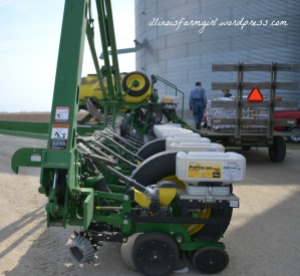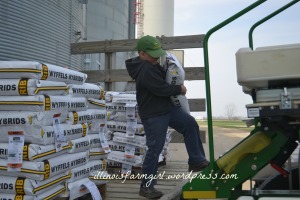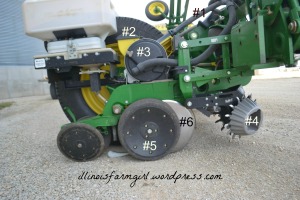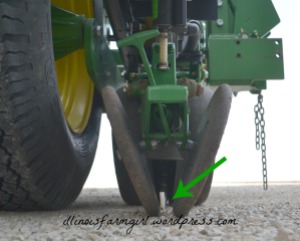 All planters have an even number of row units ranging from 2 to 48, which means a farmer could plant two rows at a time or as many as 48. On our farm, we run two 24-row hydraulic drive vacuum planters. The planter works on a system of fans creating both air and vacuum pressure. The hydraulic drive allows us to change plant population ‘on-the-go’. Plant population refers to the number of seeds planted per acre. Computers inside the planter are reading maps of soil types and yields from the previous harvest to determine how many seeds should go into an area of the field. This is part of the efficiency and sustainability story on farms today – farming with intention from planting to fertilizing to crop protection.
All planters have an even number of row units ranging from 2 to 48, which means a farmer could plant two rows at a time or as many as 48. On our farm, we run two 24-row hydraulic drive vacuum planters. The planter works on a system of fans creating both air and vacuum pressure. The hydraulic drive allows us to change plant population ‘on-the-go’. Plant population refers to the number of seeds planted per acre. Computers inside the planter are reading maps of soil types and yields from the previous harvest to determine how many seeds should go into an area of the field. This is part of the efficiency and sustainability story on farms today – farming with intention from planting to fertilizing to crop protection.  My farm boy often helps fill the planter. Here the planter is parked flush with the hayrack. He carries seed bags, ranging in weight from 40 to 60 pounds, up to Grandpa, who empties each into the hopper tanks (pictured below). Each bag seed holds 80,000 kernels. The weight of the bag is determined by the size of the kernels. Bigger kernels equal heavier bags and small kernels, lighter bags. The planter holds 100 bags of seed.
My farm boy often helps fill the planter. Here the planter is parked flush with the hayrack. He carries seed bags, ranging in weight from 40 to 60 pounds, up to Grandpa, who empties each into the hopper tanks (pictured below). Each bag seed holds 80,000 kernels. The weight of the bag is determined by the size of the kernels. Bigger kernels equal heavier bags and small kernels, lighter bags. The planter holds 100 bags of seed.  In order to understand the movement of seed through the planter, try blowing air through a drinking straw. If you put your finger on one end and blow through the other, no air can escape. Remove your finger and the air escapes. The planter works on the same concept. When the top of the hopper box is closed, the tank and the hoses become pressurized; just like if you capped a straw with your finger. The pressure causes seeds to “blow” into individual row units. This is the piece of the planter that will put the seed in the ground. A row unit is pictured and labeled below. Each row unit has its own hose (#1) that links it to the main hopper tanks. Once seeds fill the smaller hopper boxes (#2), gravity forces them into the meter. Inside each meter (#3), a seed is sucked onto a plate that is pocked with individual holes. One seed to one hole. The vacuum effect is what holds the seed to the plate.
In order to understand the movement of seed through the planter, try blowing air through a drinking straw. If you put your finger on one end and blow through the other, no air can escape. Remove your finger and the air escapes. The planter works on the same concept. When the top of the hopper box is closed, the tank and the hoses become pressurized; just like if you capped a straw with your finger. The pressure causes seeds to “blow” into individual row units. This is the piece of the planter that will put the seed in the ground. A row unit is pictured and labeled below. Each row unit has its own hose (#1) that links it to the main hopper tanks. Once seeds fill the smaller hopper boxes (#2), gravity forces them into the meter. Inside each meter (#3), a seed is sucked onto a plate that is pocked with individual holes. One seed to one hole. The vacuum effect is what holds the seed to the plate.  The bottom of the row unit prepares the soil for the seed. Row cleaners (#4) do just what their name implies. As the planter moves through the field, the cleaners push stalks, leaves and clods of dirt out of what will become the furrow. The larger black wheels are called gauge wheels (#5) and regulate how deep a seed will be planted. The silver discs (#6) are called openers because they literally open the soil to create the furrow. The seed meter continually spins dropping one seed into the ground at a time. We plant at six mph, placing 36,000 seeds per acre. In essence, we plant corn faster than a machine gun shoots bullets.
The bottom of the row unit prepares the soil for the seed. Row cleaners (#4) do just what their name implies. As the planter moves through the field, the cleaners push stalks, leaves and clods of dirt out of what will become the furrow. The larger black wheels are called gauge wheels (#5) and regulate how deep a seed will be planted. The silver discs (#6) are called openers because they literally open the soil to create the furrow. The seed meter continually spins dropping one seed into the ground at a time. We plant at six mph, placing 36,000 seeds per acre. In essence, we plant corn faster than a machine gun shoots bullets.  Once the seed drops into the furrow, the seed firmer, the small white plastic piece indicated by the arrow, presses the seed gently to the soil creating good seed to soil contact. No air should be left around the seed as the closing wheels fill the furrow with soil.
Once the seed drops into the furrow, the seed firmer, the small white plastic piece indicated by the arrow, presses the seed gently to the soil creating good seed to soil contact. No air should be left around the seed as the closing wheels fill the furrow with soil.  Each row unit on our planter is equipped with a SmartBox. The SmartBox holds a granular insecticide. The insecticide is applied both in the furrow with the seed and also on top of the closed furrow. The goal is to control a variety of pests that will harm the seed as it begins to germinate. The SmartBox is considered a closed system. In other words, My Farmer never comes into contact with the insecticide. When a box runs out it is removed and replaced with a new one. The empty boxes are returned to the company for use next year. We apply 4.4 pounds of insecticide per acre, which compares to about 4 ounces per 1,000 feet. Planters are complex machines that complete a surprisingly simple task. Depending on the day, the weather and the fields we are planting, we can cover 350 to 450 acres each day with just one planter. As of this morning we have about 200 acres of commercial corn left. It’s been a good #plant15!
Each row unit on our planter is equipped with a SmartBox. The SmartBox holds a granular insecticide. The insecticide is applied both in the furrow with the seed and also on top of the closed furrow. The goal is to control a variety of pests that will harm the seed as it begins to germinate. The SmartBox is considered a closed system. In other words, My Farmer never comes into contact with the insecticide. When a box runs out it is removed and replaced with a new one. The empty boxes are returned to the company for use next year. We apply 4.4 pounds of insecticide per acre, which compares to about 4 ounces per 1,000 feet. Planters are complex machines that complete a surprisingly simple task. Depending on the day, the weather and the fields we are planting, we can cover 350 to 450 acres each day with just one planter. As of this morning we have about 200 acres of commercial corn left. It’s been a good #plant15!




[…] ← The Anatomy of a Planter Gallery […]